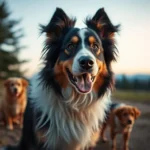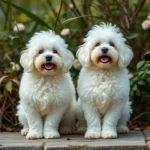
Understanding different dog breeds is essential for potential dog owners, trainers, and enthusiasts alike. Each breed carries unique characteristics, traits, and care needs that can significantly impact the lives of both dogs and their human companions. Among the many breeds, the Tornjak stands out for its rich history and versatility.
Understanding Dog Breeds
Definition of Dog Breeds
A dog breed is defined as a group of dogs that share specific characteristics and traits, including physical appearance, behavior, and temperament. Breed standards are established by kennel clubs and breed organizations, which delineate the ideal traits and qualities for each breed. These standards help maintain the integrity of the breed and ensure that dogs are bred for specific purposes, whether for companionship, work, or herding.
Factors Influencing Dog Breeds
The formation of dog breeds is significantly influenced by genetics and ancestry. Over centuries, selective breeding has been employed to enhance certain traits, such as size, coat type, and behavior. The purpose of breeding can also vary, with some breeds developed for herding livestock, others for hunting, and many for companionship. Understanding these factors is vital in recognizing the unique needs and behaviors of each breed.
The Tornjak Breed
History and Origin
The Tornjak is a traditional dog breed native to the mountainous regions of Bosnia and Herzegovina. Its history dates back to medieval times, where it was primarily used as a herding dog and guardian of livestock. The breed’s name is derived from the Torn Mountain, a significant area in Bosnia. Tornjaks were essential for protecting sheep from predators, showcasing their intelligence and loyalty.
These dogs have deep roots in the culture of the region, symbolizing strength and resilience. Despite facing near extinction during the Yugoslav wars, dedicated breeders and enthusiasts worked to revive the breed, allowing the Tornjak to regain prominence in both its homeland and beyond.
Physical Characteristics
The Tornjak is a medium to large-sized dog with a robust build. Males typically weigh between 80-110 pounds, while females range from 70-90 pounds. Their height is approximately 24-28 inches at the shoulder.
Their coat is one of their most striking features, characterized by a thick, double layer that provides insulation against harsh weather. Tornjaks come in various colors, including white, gray, and black, often with distinctive markings. Their expressive faces, with dark, intelligent eyes and strong jaws, further enhance their appealing appearance.
Temperament and Behavioral Traits
The Tornjak is renowned for its loyalty and protective instincts. These dogs are naturally affectionate towards their families, making them excellent companions. Their intelligence allows for easy training, although they can exhibit a stubborn streak at times.
Behaviorally, Tornjaks are known to be alert and vigilant, making them effective watchdogs. They tend to bond closely with their human companions and can be reserved with strangers, showcasing their protective nature. Families with children will find Tornjaks to be gentle and nurturing, although early socialization is crucial to ensure they are well-adjusted.
Care and Maintenance of Tornjaks
Nutrition
A balanced diet is paramount for the health of a Tornjak. High-quality dog food that meets their nutritional needs is essential, particularly during their growth stages. Adult Tornjaks typically thrive on a diet rich in protein and healthy fats.
Common dietary concerns include obesity, which can be mitigated by monitoring their caloric intake and ensuring they maintain an active lifestyle. Consulting with a veterinarian about specific dietary needs based on age, weight, and activity level will yield the best results.
Exercise Requirements
The Tornjak is an active breed that requires regular exercise to maintain its physical and mental well-being. Daily walks, playtime, and mental stimulation through training or puzzle toys will keep them engaged and happy.
A minimum of 60-90 minutes of exercise each day is recommended. Tornjaks enjoy activities like hiking, running, and playing fetch, which can also strengthen the bond between the dog and its owner.
Grooming Needs
Grooming is an essential aspect of caring for a Tornjak. Their thick double coat requires regular brushing, ideally two to three times a week, to minimize shedding and prevent matting. During shedding seasons, more frequent grooming may be necessary.
Bathing should be done as needed, usually every few months, or when they get particularly dirty. It is essential to use a gentle dog shampoo to maintain the health of their skin and coat.
Health Considerations
Like all breeds, Tornjaks can be prone to specific health issues. Common concerns include hip dysplasia, elbow dysplasia, and certain genetic conditions. Regular veterinary check-ups are crucial for early detection and management of potential health problems. Keeping an eye on their weight, providing a balanced diet, and ensuring they have regular exercise will contribute to their overall health.
Training a Tornjak
Importance of Training
Training is vital for a Tornjak to develop into a well-mannered adult dog. Early socialization and obedience training help them become confident and well-adjusted. These dogs are intelligent and eager to please, making them relatively easy to train when positive reinforcement techniques are used.
Training Techniques
Utilizing positive reinforcement, such as treats and praise, is highly effective for training Tornjaks. Starting with basic commands like sit, stay, and come can lay a strong foundation for further training.
Group classes can also be beneficial, offering both socialization and training opportunities. Engaging in regular training sessions not only enhances their skills but also strengthens the bond between the dog and its owner.
Common Behavioral Issues and Solutions
Tornjaks may exhibit behavioral issues if not trained properly or if they do not receive enough exercise and mental stimulation. Common problems include barking, digging, or being overly protective.
Addressing these issues early on with consistent training and positive reinforcement can lead to effective solutions. Consulting with a professional dog trainer can provide additional strategies for managing and correcting unwanted behaviors.
Tornjak as a Family Pet
Compatibility with Children and Other Pets
The Tornjak is known for its gentle and protective nature, making it a suitable family pet. Their affectionate demeanor towards children can foster a loving environment. However, it is essential to supervise interactions, especially with younger children, to ensure safety and positive experiences for everyone involved.
When introducing a Tornjak to other pets, gradual introductions are recommended. Their natural herding instincts may lead to chasing smaller animals, so training and supervision are crucial during the initial stages of integration.
Living Environment Needs
Tornjaks thrive in spacious environments where they can roam and explore. While they can adapt to apartment living, it is essential to provide ample daily exercise and mental stimulation. A house with a secure yard is ideal, allowing them to engage in natural behaviors while ensuring their safety.
Adverse weather conditions should be considered as well, as Tornjaks are best suited for cooler climates due to their thick coats.
Adoption and Breeding
For those interested in welcoming a Tornjak into their home, there are various avenues to consider. Adoption from shelters or breed-specific rescues can provide a loving home for a dog in need.
If opting to purchase from a breeder, it is vital to choose a reputable source that prioritizes health and temperament over aesthetics. Researching breeders and asking for health clearances can help ensure a healthy and well-adjusted puppy.
Conclusion
The Tornjak is a remarkable breed with a rich heritage and a loving demeanor. Understanding their characteristics, care needs, and training requirements is crucial for potential owners. With the right environment, training, and socialization, Tornjaks can thrive as loyal family pets and companions. Their unique qualities make them a breed worth considering for anyone looking to add a furry friend to their family.
FAQs
What is the average lifespan of a Tornjak?
The average lifespan of a Tornjak is typically between 10 to 14 years, depending on their health and care.
Are Tornjaks easy to train?
Yes, Tornjaks are generally easy to train due to their intelligence and eagerness to please, especially when positive reinforcement methods are used.
How much exercise does a Tornjak need daily?
A Tornjak requires at least 60-90 minutes of exercise daily to maintain their physical and mental health.
Are Tornjaks good watchdogs?
Absolutely, Tornjaks are known for their alertness and protective instincts, making them excellent watchdogs for families and properties.









